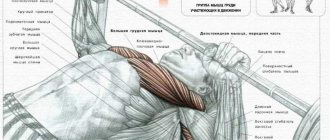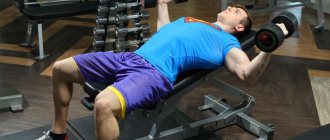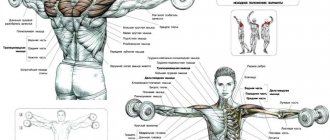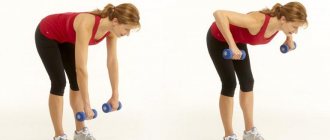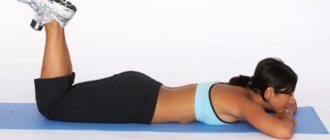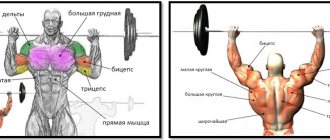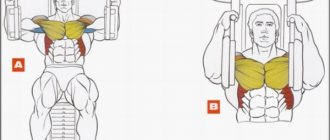7 November 2015 Admin Home page » Breast
This article describes in detail the technique of performing dumbbell flyes while lying on an incline bench, the muscle groups being trained, and outlines important tips and videos for performing the exercise correctly.
Exercise Basics
The main rule is to perform the exercise slowly, slowly lowering the dumbbells down and powerfully, but without jerking, bringing them up at the top. If you lower down suddenly, there is a high probability of injuring the shoulder ligaments.
The angle of inclination of the back of the gymnastic bench should be no more than 30 degrees; this is precisely the inclination when the upper pectoral muscles stretch well. If you set the angle to 45 degrees, the load will not be on your shoulders and your chest will be distributed equally 50 to 50.
It is clear that the weight of the dumbbells will have to be reduced - since this is not a dumbbell press on an inclined bench, where the triceps work, in our case the triceps rests.
Execution technique
We have already understood that the center of influence on the pectoral muscles changes depending on the angle of the bench. The principle of performing the exercise will be the same everywhere, but the weight of the dumbbells will change. After all, not everyone, for example, has a well-developed upper chest from the very beginning. But of course, the desire to achieve good results and productive work in the gym will help get rid of the imbalance.
Initial position
Horizontal bench
In my opinion, the easiest wiring option of all. Involves the lower and middle part of the pectoral muscles.
- Lie down on a flat bench press. The shoulder blades are pressed, the legs are shoulder-width apart, the feet are firmly on the floor, there is a deflection in the lower back.
- Take dumbbells in your hands and lift them up. Remember we start and finish the exercise only at the top point!
When the bench is tilted up
The principle of the exercise remains the same, but the load shifts from the middle to the top of the pectorals. You must understand that the same pectoralis major muscle will work, but not all of it, but only the upper part (clavicular) and middle (sternocostal). The lower part (abdominal) will also be involved, but to a very small extent.
- Install the bench press with the backrest up. The angle of inclination can be used from 35 degrees to 60. However, it is better to change it in each approach. This way you will work your pecs as much as possible, in every plane.
- We install the bench seat so that the angle between the two parts is 90 degrees.
- Let's go to bed. The shoulder blades are pressed, the legs are on the floor, the lower back is arched, the buttocks rest against the bottom of the bench.
- Take dumbbells and lift them up.
When the bench is tilted down
This version of the dumbbell raise is the most technically difficult. With this angle of inclination of the bench, the lower part (abdominal) of the pectoralis major muscle is maximally involved in the work. Although this option for performing the placement occurs most often, if you want to become the owner of the most prominent breasts, then you must perform it.
- To perform this exercise, you will need a special bench with bolsters for your legs so as not to roll down.
- The tilt angle is 30-40 degrees minus.
- We lie down on the bench. The shoulder blades are pressed, the legs are held by the bolsters, there is a deflection in the lower back.
- We take dumbbells in our hands and lift them up. There is a slight bend in the elbows.
When your head is lower than your body, much more blood flows to it. As a result, intracranial pressure increases, and this can lead to dizziness and loss of consciousness. Therefore, it is better for older people to avoid this exercise.
Performance:
- Install the bench press by choosing the incline angle that suits you. We have already talked about this above.
- We take dumbbells in each hand and lie down on the bench; if they are heavy for you, use your legs to lift them to the top.
- Take a stable body position. Legs shoulder-width apart, feet resting on the floor. The shoulder blades are brought together and pressed against the bench. There is a slight arch in the lower back.
- We hold dumbbells above our shoulders. The arms are slightly bent at the elbow joint. The elbows will remain in this position until the end of the approach.
- As you exhale, spread your elbows to the sides and properly stretch your chest.
- As you inhale, lower the dumbbells to the starting position. There is no need to knock them against each other in the upper phase.
The correct technique will provide you with maximum muscle growth and protect you from injury for a long time. There is one point that will help to load the muscles as much as possible. This is an inward rotation of the dumbbells while lifting up.
. As you curl the dumbbells, rotate them clockwise 180 degrees so that your thumbs point toward each other. This movement will help to maximally load the chest muscles, since one of their functions is to turn the arms inward.
Important Tips
1) You often have to perform dumbbell flyes while lying on an inclined bench without an assistant, and it is not always possible to quickly throw them from the floor onto your chest, especially since a sudden movement can pull the shoulder muscles. To do this, place the dumbbells on your knees, and then leaning back, throw the dumbbells to your chest with your knees, from where you can easily squeeze them up.
2) Lower the dumbbells down no lower than shoulder level, and turn your hands inward; in this position, the chest muscles are well stretched, and your shoulders are less likely to get injured.
3) When you bring the dumbbells together at the top point, you need to straighten your arms completely, this will allow you to contract your chest more strongly and feel the peak of the contraction.
4) In general, dumbbell flyes while lying on an inclined bench are done in 2 ways: Turning your hands outward and vice versa, bringing them inward, try both options and where you feel your chest better, do so, but as I said earlier, when the hands are inward, the tension is on the shoulders less.
5) When doing dumbbell raises, bend your elbows slightly; don’t try to do it with straight arms, otherwise the elbow joint may get injured.
6) This is not an exercise where you should set records, so leave it to the barbell bench press, choose dumbbells with a working weight at which you will do 10-12 repetitions. Your task is to stretch the muscles to the maximum, for their further contraction with other pressing exercises for the chest.
7) It is generally accepted that the lift is 15-20% of the one-rep maximum in the bench press, this means if you press 120 kg for 1 rep. This means the weight for wiring = 18-24 kg.
I wish everyone a pleasant training without injury, don’t be lazy and take care of yourself
